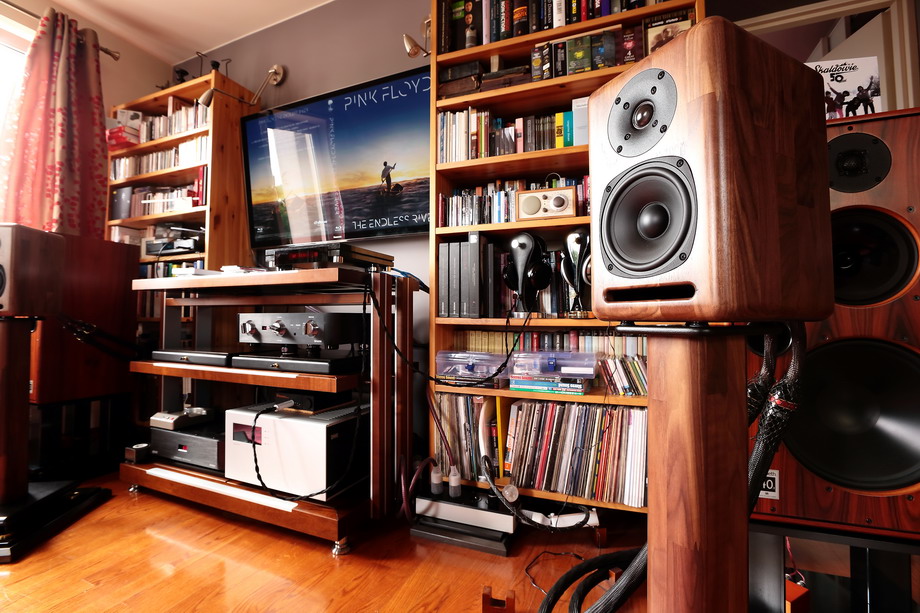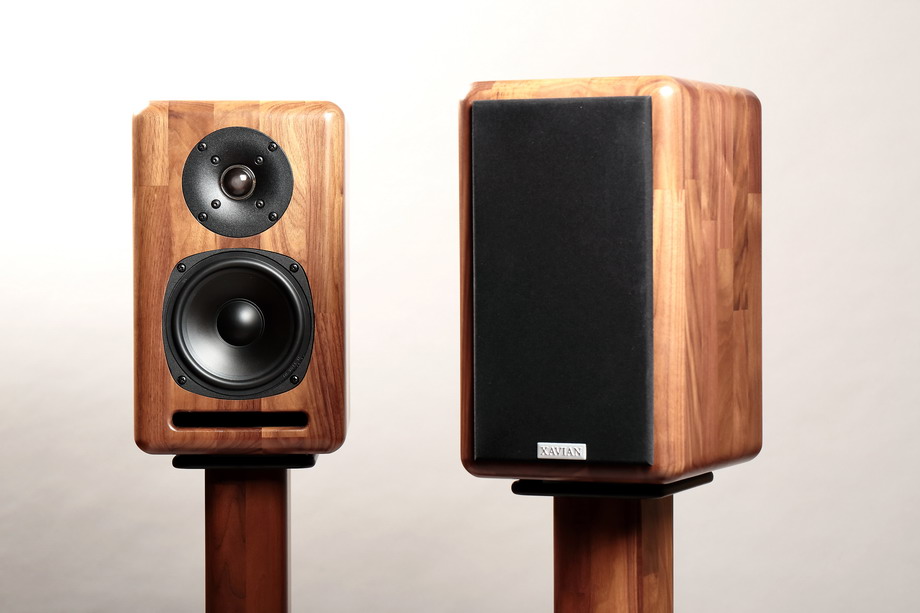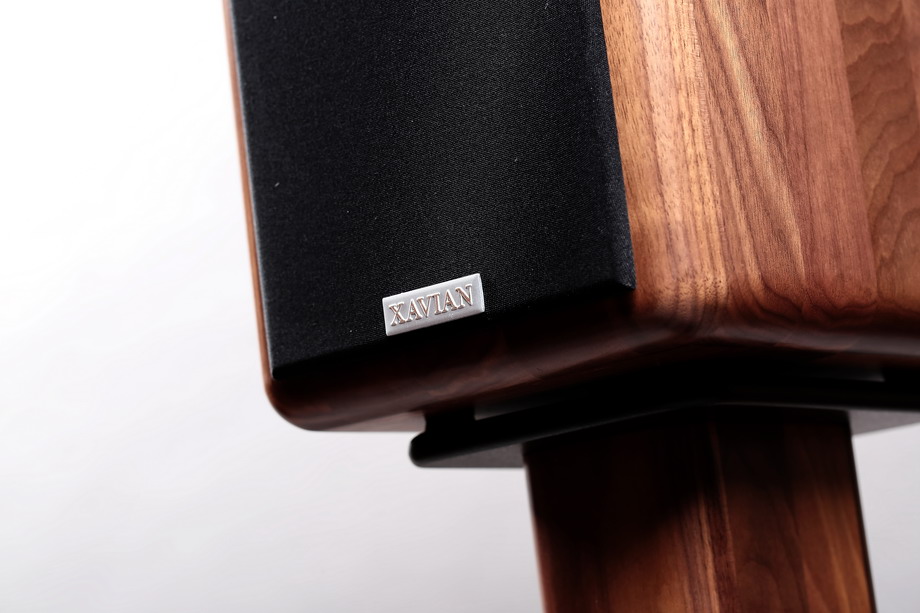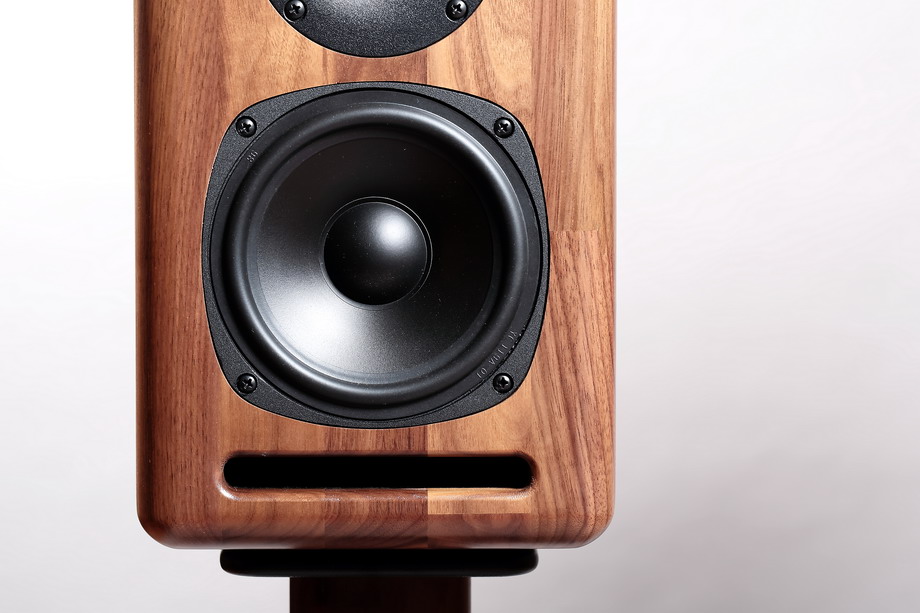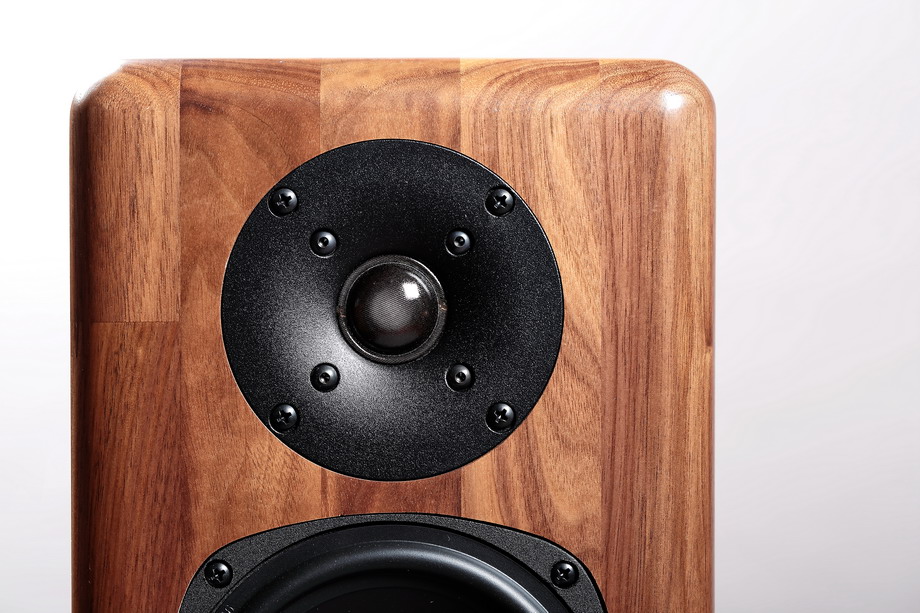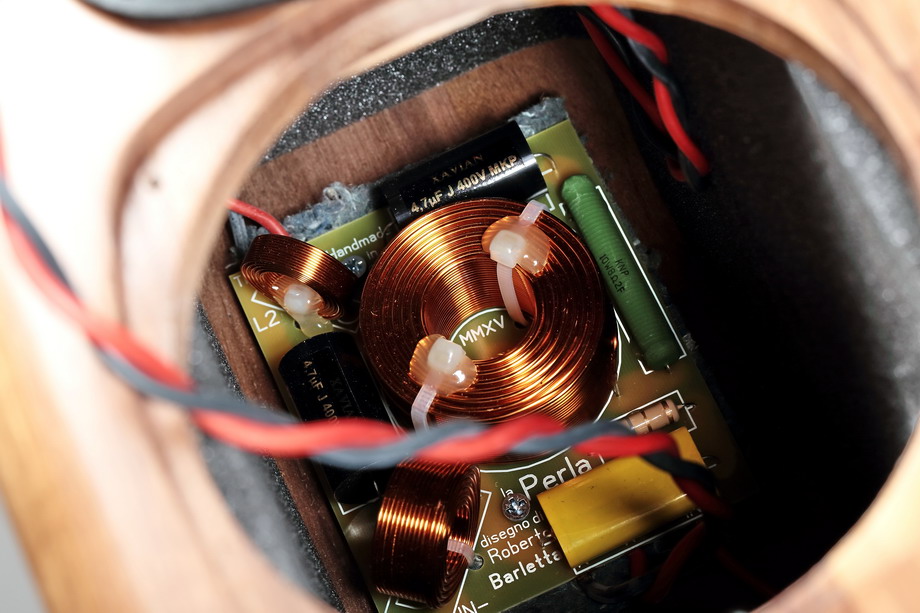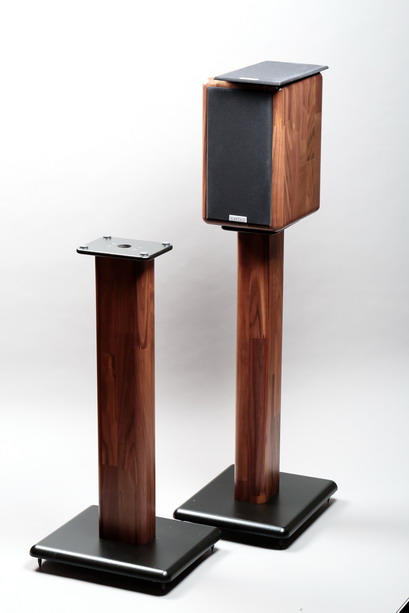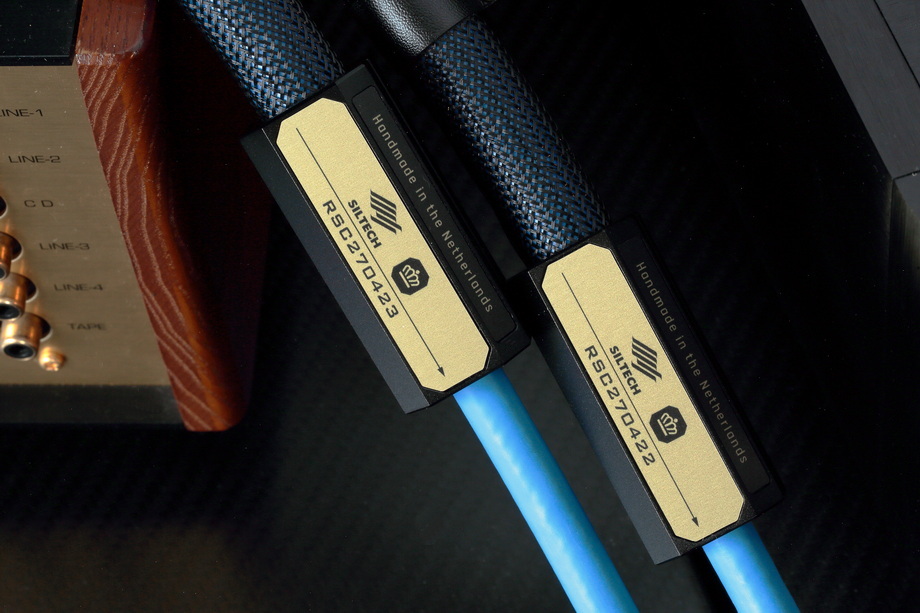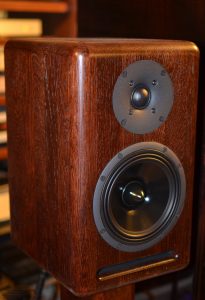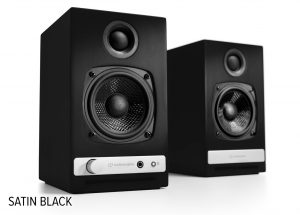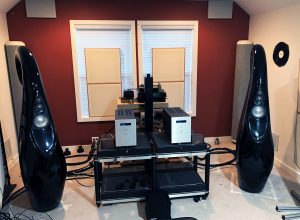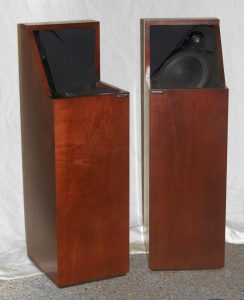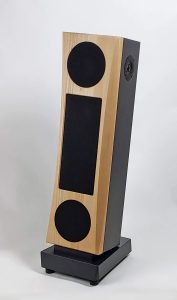Edwin van der Kleij, the owner of Siltech, is a great fan of speakers designed by Franco Serblin. Over the years he bought all his designs with Sonus faber logo, and later with Franco Serblin one, too (see HERE and HERE). As he told us during Cracow Sonic Society meeting in Cracow, death of Mr Serblin was a huge shock for him and a great loss for audio industry.
Edvin appreciates Franco's speakers for the same set of features he also loves dCS products (Vivaldi and Puccini) for teir make & finish is very solid which gives a user certainty that they will work very well for years, they are based on solid engineering, and there is one more element—this little spark of talent of their creators that makes them so special.
Despite his love for all Serblin's creations Edwin has his own favorites with the brightest star of them all—the Electa Amator II. As you probably know, Janusz, one of the hosts of CSS meetings, owns these speakers despite the fact that they cost less than cables in his system.
What makes this model so unique? A combination of a perfect cabinet with high quality drivers and refined crossover. And while the latter is often modified to make these speakers sound even better, even the basic version makes these speakers sound remarkable—one can use them with system that is several times more expensive and still they don't have to be the weakest link in such system.
One of the elements that made Franco Serblin's products to stand out among other speakers, was a unique cabinet made of wooden planks. Such a cabinet was build for the top model Guarnieri Homage, but also for relatively inexpensive models like Minima Vintage. One could call it "Italian style", because it is Italians who are capable of turning such a design into art. There are a lot of speakers with wooden cabinets—most of them don't look particularly attractive, and even less among them perform well. Italian speakers being an exception here.
As it turns out it is not really about where such speakers are made but rather about who makes them. Just take a look at Xavian Perla loudspeakers and you will immediately recognize similarities between these speakers and creations of Franco Serblin, that result also in similarities of their performances confirmed during listening sessions. Man behind Xavian is Italian, Roberto Barletta, who lives in Prague in Czech Republic. This explains why a very nice, well made manual starts with an Italian version.
These are small, two-way monitors, sporting wonderful, wooden cabinets made up of perfectly fitting planks of solid Italian walnut (that are actually imported from Italy). Low- and midrange is delivered via 150 mm driver with polypropylene cone and solid, moulded basket. Tweeter is a 26 mm soft, silk dome. Both are custom drivers made in Italy. It is a front-vented cabinet, but not with a classic, round b-r port but rather with a slot-type placed below woofer. Roberto decided to use magnetic grills for an aesthetic factor.
Dimensions of these speakers are similar to those of above mentioned Minima Vintage Sf. Perla represents a new line of Xavian products, called Natura. Another product from this line is a high-end monitor called Orfeo, and the next model to be released will be a floor-stander
Perla premiered in Poland on May 29/30 in Gdańsk in Premium Sound showroom. Roberto Barletta was present and he described his new design as follows:
Perla is a compact two-way speaker with front bass-reflex. The cabinet is made of solid Italian walnut with a structure that we call "mosaic". The magic of Perla catches you at glance: just admire and touch her. Fascination becomes euphoria when she starts playing music. Sophisticated crossover in series, selected components, simple installation and an exclusive appearance create a recipe that you can not resist.
Equally amazingly looking stands are available as option with their "legs" made up of the same wooden planks as speaker's cabinet.
SOUND
Recordings used for this test (a selection):
- Sing with the Voice of Melody, performed by Stile Antico, Harmonia Mundi USA HMU 807650, SACD/CD (2015).
- Byrd, McLean, Coltrane, Taylor’s Wailers, Prestige/Analogue Productions CPRJ 7117 SA, SACD/CD (1957/2013).
- Eddie Vedder, Into The Wild, soundtrack, Sony Music 88698-18240 2, CD (2007).
- J.S. Bach, Goldberg Variations BWV 988. 1981 Digital Recording, Glen Gould, Sony Classical/Sony Music Entertainment Hong Kong 88765440092, "No. 0197", gold-CD (1982/2013).
- Kazumi Watanabe, Jazz Impressions, Ewe Records EWSA 0163, SACD/CD (2009).
- Mark Hollis, Mark Hollis, Polydor 537 688-2, CD (1988).
- Ornette Coleman, The Shape of Jazz to Come, Atlantic Records/ORG Music ORGM-1081, SACD/CD (1959/2013).
- Pink Floyd, The Endless River, Parlophone Records 4621333, CD + Blu-ray (2014).
- Tangerine Dream, Phaedra, Virgin Records/Universal Music LLC UICY-40130, Platinum SHM-CD (1974/2015); review HERE .
- Vangelis, Spiral, RCA/BMG Japan 176 63561, K2 SHM-CD (1977/2008).
Compact, stand-mount speakers are made to fit small rooms, being placed close to the listener and avoid problems with room's acoustics. They were never supposed to replace big floor-standers—wherever conditions allow larger speakers will always perform better.
Some situations require such specialized, compact speakers, though. And then they might cost a much, or even more than large floor-standers What is important is that they do their job in the best possible way.
These "sweet Latvians"—that's what everybody who visited me during this test said—are such goal oriented tools. They offer rich, deep sound, rather warm than bright. Acoustic instruments and voices in natural spaces sound absolutely amazing. It is not the first time when I encountered such a dense, natural sound. Before though, I experienced it when using large floor-standers or monitors, but much more expensive ones. The last speakers that sounded like that in my room were... Sonus faber Vintage Minima. Perla in some aspects even outperform Sf speakers.
The last album of Talk Talk, Laughing Stock was for its leader, Mark Hollins, a shot in his own foot. AT least from commercial point of view. Producer also had his doubts so instead of releasing this album with EMI (like previous ones), released it with Polydor. And, as it turned out, he was right to be skeptic about this music. Sales results of this album were a disaster. Despite the fact that it was actually a fantastic piece of music. When Mark Hollis created his own solo album its artistic character was as similar to this album as possible.
The solo debut of Talk Talk vocalist is a collection of live acoustic improvisations recorded in a studio. This translates into fantastic quality of these recordings. Perla responded to such quality in a very positive way. It turned out they didn't sound dark at all, although warm and they conveyed a lot of micro-information, also those concerning dynamics. With "heavier" material they tend to "close" presentation a bit and deliver it in slightly rounded way, though.
These loudspeakers made me curious about how this or that album will sound like when played via Perla. Speakers Mr Barletta created tend to drag listener into their specific, but very attractive world. They try to show you the better side of the world, without hiding its shortcomings, but focusing on its advantages. If there are bright sides of particular recording, Perla will let them really shine, if there are none, Perla will serve you a nice performance but there will be no excitement you've experienced with those better quality recordings.
Tonal balance seems pretty even. Both range extremes are rolled-off—one should count on very deep bass, nor on highest treble—these speakers won't offer that. I think Mr Barletta did make an informed decision—instead of trying to make Perla sound bigger than they really are, he accepted their limitations and within this perimeter he tried to realize his vision of sound. And this vision focuses on timbral accuracy, coherency and spacing. All these three elements are linked together and the result is something more than just timbre, coherency and spacing.
It's a vivid presentation. Texture of instruments seems really dense, but when it comes for example to acoustic guitar it is vibrant and presented with quite firm leading edge. When it comes to recordings with a lot of microphone-related noise—like on Hollis' album—or a noise coming from a lot of "air" in a large space—like in Stilo Antico recordings—these speakers present it immediately. They brighten the sound, don't emphasize these elements, but create a large image completely filling the space between speakers. This type of presentation, I mean delivering music as a 3D image between speakers, instead of delivering several smaller, separate images, is very difficult to achieve for any speakers, as it required a very good integration between drivers of loudspeakers, and they also need to be particularly resolving.
These speakers are impressively resolving. Although this feature does not present itself with abundance of details. But when Glen Gould murmurs and sings, when Hollis gently phrases his singing, and finally when singers of Stilo Antico pass the baton between themselves, we can hear that as a natural element of the music, as its integral part and not just another "detail".
This works also with recordings that are not that perfect like with electronic music of Tangerine Dream, or the last album of Pink Floyd, The Endless River. Both these recordings sound quite nice even on small systems, but the dynamics seems limited. Presentation of dynamics depends on how resolving particular system is and how well it deals with details shading. With Perla both recordings sounded in a very beautiful way as they offered momentum, when needed, or a very good focus, when required.
Summary
These compact, wonderfully looking speakers perform, in my honest opinion, remarkably. They don't... impose their presence on a listener, they don't try to wow him. What they can do very well is to convey the natural sound of instruments, to create a huge, three-dimensional, essential soundstage. They lack solid bass foundation so the volume of instruments is not that big like from larger loudspeakers, but that's exactly what one should expect, that's the "cost" of making compact speakers.
It's a resonant, rich, mature sound that will work very well whenever one expects a natural sound of high quality in a small room. They are very good at differentiating recordings so a listener may fully enjoy differences between recordings and performances, like, for example, between mono version of Taylor’s Wailers from 1957 with totally different, much better version on the 1959 Ornette Coleman's The Shape of Jazz to Come and 2009 Kazumi Watanabe's Jazz Impressions. This is this sort of presentation that never forces you to analyze what you hear—music always comes first and all the rest is given only if you're interested in hearing it.
DESIGN
The dimensions of Sonus faber Minima Vintage loudspeakers, that I reviewed some time ago, were very similar to those of Perla. Their woofer was smaller though, and the front of their tweeter bigger. What is similar between Xavian and Sonus faber speakers is that both are two-way, vented stand-mount speakers. Perla sport a silk dome, Ø 26 mm, tweeter with a plastic front that looks like a short horn. It is supposed to improve sound dispersion and has little to do with sensitivity increase. Low and midrange are reproduced by a 150 mm driver with a polypropylene cone. It sports a rigid basket and a soft dust cup made of the same material as the cone. Crossover point is set quite high up the range, at 3 kHz, so most of the midrange is played by this woofer. Woofer is loaded with a front bass-reflex with a slot-type port placed close to the lower edge of the front baffle.
The speaker post are quite particular. Xavian for years had them custom made. And thus all of them carried Latvians logo, and so do the ones used for Perla. These time those particular speakers post do not accept a naked wire—only bananas and spades. It is quite surprising by the way, that even the top speakers post manufactured today still accept naked wire although I do not know even a single person, who uses this solution, nor have I heard about anyone who does that anymore! So in fact what Xavian did is very logical (although obviously not for everybody)—they designed posts that accept only what audiophiles use today—spade and banana plugs. This decision allowed them to design smaller posts, that look nicer, and, which is also very important, less metal was used to build them, which is a good thing sonic-wise.
Looking at the crossover one would appreciate both, high quality components and the whole, orderly design. It is mounted on a small PCB with 3 air coils, 3 polypropylene capacitors and two resistors (carbon and wire one). I saw pictures of prototype and than Roberto used lesser elements. Coils are placed at an angle of 90 degree to each other (bot horizontally and vertically) which minimizes an interference of magnetic fields. Capacitors are branded with Xavian logo, which means they are custom made. Assembly of each unit of Natura speaker is supervised by Roberto Barletta himself, which is indicated on the crossover plaque.
Cabinet is made of solid Italian walnut that is actually imported from Italy. Material is stored for at least three weeks before processing. It is cut to planks and these are glued together - Mr Barletta calls it a "Mosaic". Manual suggests that user should listen to Perla with grills off—this should improve both, sonic and aesthetic aspects of these speakers. Leaving grills on might result in a bit darker color of the front (hidden from sun-light) than the rest of the cabinet exposed to the light. So manufacturer suggests that for the first three month user leaves grills off. Manufacturer also suggests a 200 hours break-in period for Perla. We received speakers for the review after initial break-in period.
Stands delivered with Perla reminded me those that Sonus faber delivered for their Minima Vintage speakers—black upper and lower plates with w wooden "leg" between them. Xavian decided to use lighter and less expensive plates of MDF (instead of steel ones that Sonus faber used). Stands sport adjustable spikes but nothing to put under them, so I'd suggest using something really effective like, for example, Franc Audio Accessories feet. Upper plate is smaller than lower one, and it sports rubber washers for cabinets safety.
The "wooden leg" is made of the same looking planks as the speakers' cabinets. It is hollow so one might put a speaker cable inside the leg, provided that one uses flat enough to fit the opening between upper plate and speaker itself.
Specifications (according to the manufacturer):
- Low- midrange driver: Ø 150 mm
- Tweeter: Ø 26 mm
- System: bass-reflex
- Frequency response: 55—20 000 Hz (-3 dB on reference axis)
- Nominal impedance: 8 Ω
- Crossover frequency: 3000 Hz
- Sensitivity: 88 dB (2,83 V/1 m)
- Recommended amplifier power: 30 - 120 W
- Dimensions: 315 x 190 x 236 mm (HxWxD)
- Weight: 6,9 kg/pc.
Xavian PERLA Loudspeakers
Price (at the time of this test): 6500 PLN/pair
Za Mlýnem 114
253 01 Hostivice—Prague
MADE IN CZECH REPUBLIC
Text: Wojciech Pacuła
Images: Wojciech Pacuła




